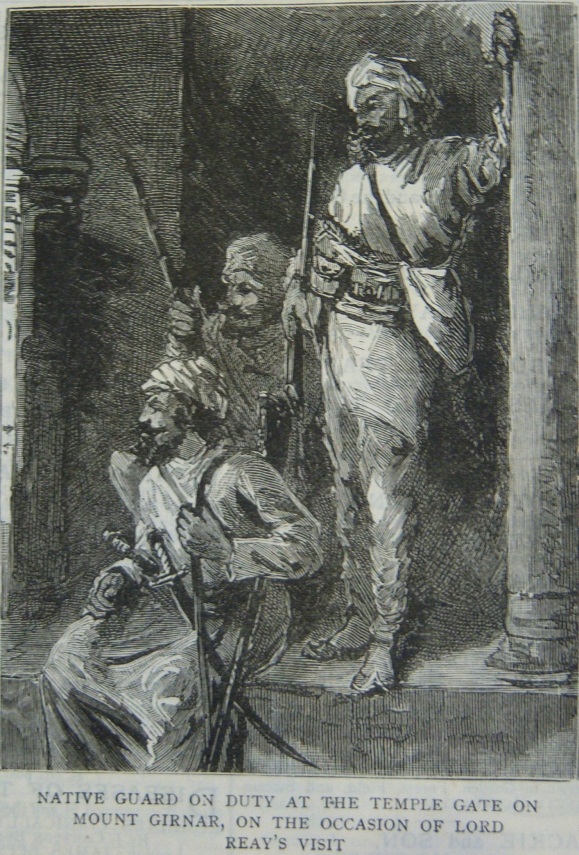Chapter outline and page reference:
Introduction 109
Bhim Kund 119
Chandraprabha Swami Temple 120
Chaumukhji Temple 121
Dharamchand Hemchand Temple 122
Digambar Neminath Temple 123
Gaumukhi Ganga 124
Gumasta Temple 125
Gyanvav Temple 125
Hathi-pagla Kund 126
Kumarapala Temple 128
Mahavir Temple 130
Malakavisi Temple 130
Mallavwala Temple 133
Manoharbhuvan 134
Man Singh Bhoja Raja’s Temple 134
Nagimata ki Deri 135
Neminath Temple 136
Panchabai Temple 157
Premchandji Cave 157
Rajul Cave 158
Ratan Bag 159
Rathanemi Temple 160
Rishabhdev Temple 161
Sachakaka 162
Samprati Raja Temple 162
Satpuda Reservoir 166
Seshavan Temple 166
Soni-Parsvanath Temple 168
Suraj Kund 172
Vastupalavihara 172
Chapter preview (first three pages only):
Figure 7. Jain temples of Dev-kot with Girnar Taleti and Bhavnath Valley beyond and Junagadh in the background (photo by Wainer 2008).
Introduction
At Mount Girnar, on a rocky shelf at a height of about 890 m, and a 90 minutes’ climb from the base of the steps, is a group of 16 Jain sanctuaries, 14 of which belong to the Svetambar tradition; the largest is dedicated to Neminath. These Jain temples, which stand on the ledge at the top of a great cliff, constitute a temple city called Dev-kot (Fortress of the Gods), similar to but smaller than the temple city at Satrunjay. The monuments date from the Solanki period, as well as from later centuries. Dev-kot is also known to Jains as Neminath Peak and Uparkot Peak. The location of the Jain derasars (temples) on Mount Girnar is a Notified Archaeological Site under the Protected Monuments Act.
Brown (1942, page 134) commented on Jain mountain-top temple-cities, one of which occurs on Mount Girnar: ‘…the Jains…at some remote age, having appropriated certain “mountains of immortality” as sacred sites, they proceeded to erect on their summits a considerable aggregation of religious buildings, so that these formed what may be called temple-cities. To use their own words they “ornamented these holy hills with a crown of eternal Arhat chaityas (tabernacles of saints) shining with the splendour of jewels.” In spite of the known antiquity of these mountain sanctuaries few of the temples comprising them are earlier than the fifteenth century, and most are much later. Various causes have been responsible for the older buildings having been obliterated, one being the practice of the Jains themselves of pulling down their temples when decayed and erecting new ones in their places, many of the walls bearing evidences of this, as they reveal stones of previous structures having been built into them. Again, the creed during its long history has not been free from internal dissentions, an iconoclastic schism in the fifteenth century possibly being one of the factors responsible for few buildings having survived before this date. On the other hand the peculiarly militant appearance of some of these structural complexes as a whole implies that outside forces may at one time have subjected them to desecration and pillage, from a repetition of which they are now materially guarded. For, as they exist at present, these religious sites are surrounded by embattled walls, with their interiors divided up into tuks or wards, like the inner courts of fortifies cities, the crenellated parapets being loop-holed and embrasured, each tuk having massive circular bastions at its angles, entry being obtained through strong gateways…These temple-cities, or tirthas (places of pilgrimage) are laid out on no specific plan, the buildings being arranged on such level spaces as the contours of the hill naturally provide…Each tirtha represents centuries of devotion which found expression in temple building, and they form the central object of pilgrimages and festivals at frequent intervals. Although many of the temples may seem complicated in appearance, each is designed, as a rule, on the principles common to the religious architecture of the late mediaeval period, the elaborations being due to such factors as the addition of numerous supplementary shrines, to the application of double stories, and to the practice of imposing pillared cloisters around all the larger examples.’
Figure 8. ‘Native guard on duty at the temple gate on Mount Girnar, on the occasion of Lord Reay’s visit in 1887’, a sketch by Surgeon-Major Lewis A Irving (from The Graphic 1887).
In the 19th century Burgess (1876) noted that the door into the Dev-kot or sacred fort, is evidently part of an old building, which still goes by the name of Rah Khengar’s Mahal or palace; and probably it is the lower floor of some such structure, built perhaps both as a summer palace and a stronghold, now modified to form a barrack for the guard and dwelling for the pujaris and temple priests. Other sites at Dev-kot said to be Rah Khengar’s palace include the Samprati Raja Temple, the Mallinath Temple, and the building in the courtyard of the Neminath Temple, but Shukla (1932) has pointed out that in fact the palace never existed.
Built into the wall on the left of the entrance is an inscription in Sanskrit. A genealogy of the Chudasama kings can be found here from the first Naughana, who gained the throne by the assistance of the Ahirs in the 10th century (Jacob

